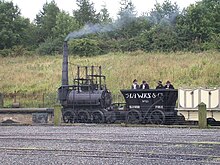No, not an April Fool's Day joke - a real steam elephant!
Here is a better look at her!
Steam Elephant
From: Wikipedia, the free encyclopedia
'Steam Elephant' from an 1820 painting
An illustration of the locomotive first came to modern attention in 1931 and it was then generally assumed to be the work of George Stephenson. More recent interpretation is based on research carried out at Beamish Museum for construction of a replica to work there based largely on contemporaneous paintings (one being the earliest known oil of a steam locomotive, by an unknown artist) and other material from the Museum archives,
It is from the paintings that the name Steam Elephant has become associated specifically with this locomotive.
Replica Steam Elephant locomotive, Beamish Museum
.
As for Stephenson's Killingworth locomotives of the year before, it had a centre-flue boiler with two vertical cylinders of about 9 by 24 inches (230 mm × 610 mm) set into its top centreline. The cylinders drove slide bar mounted beams which turned crankshafts driving the axles through 2:1 reduction gears between the frames. It had a tall, tapering chimney, the lower part being surrounded by a feedwater heater. It would have weighed about 7.5 tons and had a top speed of around 4.5 miles per hour (7 km/h) and a load capacity of about 90 tons over a short distance
.
It is now considered to have been designed by John Buddle and William Chapman for the Wallsend Waggonway and colliery at Wallsend on the north bank of the River Tyne in 1815 using metal components supplied by Hawks of Gateshead. It appears originally not to have been very successful at Wallsend, probably due to lack of adhesion on the wooden rails there, nor on trial at Washington. Following the introduction of iron rails at Wallsend, it had a working life there longer than many contemporaneous locomotives, until at least the mid-1820s
.
There is evidence that it was then rebuilt for use at the Hetton collieries, working there for a further decade.


GEARS!
ReplyDeleteBut they hid them. :-(
Interesting engine.
Reminds me of the early oil well rigs!
Delete